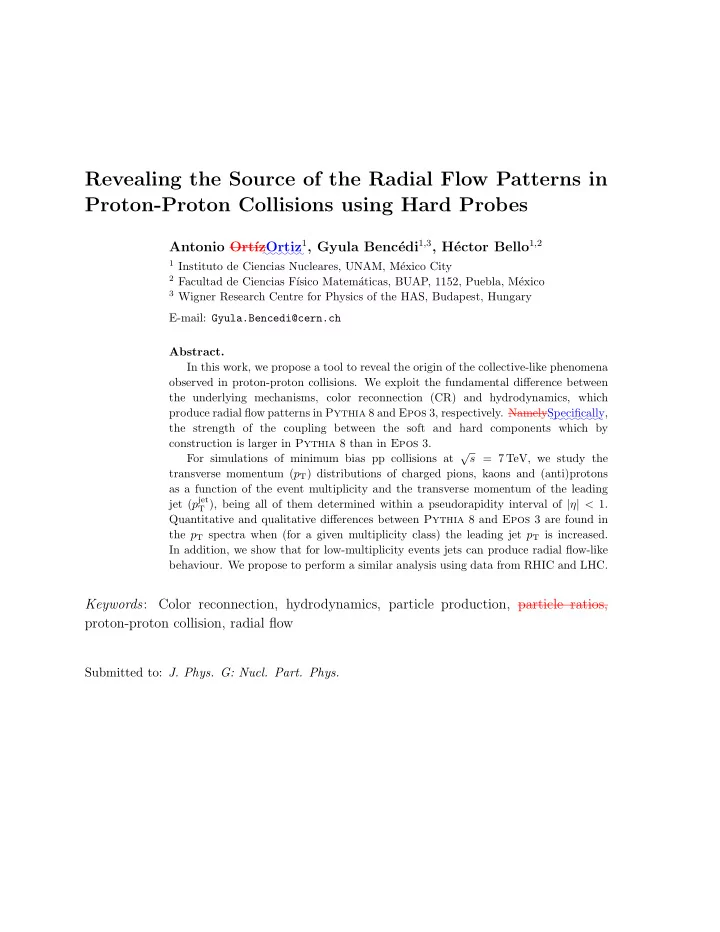

Revealing the Source of the Radial Flow Patterns in Proton-Proton Collisions using Hard Probes Ortiz 1 , Gyula Benc´ edi 1 , 3 , H´ ector Bello 1 , 2 Antonio Ort´ ız ✿✿✿✿✿✿✿ 1 Instituto de Ciencias Nucleares, UNAM, M´ exico City 2 Facultad de Ciencias F´ ısico Matem´ aticas, BUAP, 1152, Puebla, M´ exico 3 Wigner Research Centre for Physics of the HAS, Budapest, Hungary E-mail: Gyula.Bencedi@cern.ch Abstract. In this work, we propose a tool to reveal the origin of the collective-like phenomena observed in proton-proton collisions. We exploit the fundamental difference between the underlying mechanisms, color reconnection (CR) and hydrodynamics, which produce radial flow patterns in Pythia 8 and Epos 3, respectively. Namely ✿✿✿✿✿✿✿✿✿ Specifically, the strength of the coupling between the soft and hard components which by construction is larger in Pythia 8 than in Epos 3. For simulations of minimum bias pp collisions at √ s = 7 TeV, we study the transverse momentum ( p T ) distributions of charged pions, kaons and (anti)protons as a function of the event multiplicity and the transverse momentum of the leading jet ( p jet T ), being all of them determined within a pseudorapidity interval of | η | < 1. Quantitative and qualitative differences between Pythia 8 and Epos 3 are found in the p T spectra when (for a given multiplicity class) the leading jet p T is increased. In addition, we show that for low-multiplicity events jets can produce radial flow-like behaviour. We propose to perform a similar analysis using data from RHIC and LHC. Keywords : Color reconnection, hydrodynamics, particle production, particle ratios, proton-proton collision, radial flow Submitted to: J. Phys. G: Nucl. Part. Phys.
Revealing the Source of the Radial Flow Patterns in Proton-Proton Collisions 2 1. Introduction The study of particle production in high-multiplicity events in small collision systems at the LHC has revealed unexpected new collective-like phenomena. In particular, for high-multiplicity proton-proton (pp) and proton-lead (ppb ✿✿✿✿✿ p-Pb) collisions, radial flow signals [1, 2], long-range angular correlations [3, 4], and the strangeness enhancement [5, 6, 7] have been reported. Those effects are well known in heavy-ion collisions, where they are attributed to the existence of the strongly interacting Quark-Gluon Plasma (QGP) [8, 9, 10]. Understanding the phenomena is crucial because for heavy-ion physics, pp and ppb ✿✿✿✿✿ p-Pb ✿ collisions have been used as the baseline (“vacuum”) to extract the genuine QGP effects. However, it is worth mentioning that no jet quenching effects have been found so far in ppb p-Pb ✿ collisions [11], suggesting that other mechanisms could ✿✿✿✿✿ also play a role in producing collective-like behaviour in small collision systems [12, 13]. Hydrodynamic calculations reproduce many of the observations qualitatively [14]. However, it has also been found that multi-parton interactions (MPI) [15] and color reconnection (CR) as implemented in Pythia [16] produce radial flow patterns via boosted color strings [17]. Moreover, within the dilute-dense limit of the color glass condensate, it has been demonstrated that the physics of fluctuating color fields can generate azimuthal multi-particle correlations [18]; and the mass ordering of elliptic flow when the fragmentation implemented in Pythia is included [19]. The same observable has been studied using the multi-phase transport model [20], where the ridge structure can be generated assuming incoherent elastic scatterings of partons and the string melting mechanism. Other mechanisms like “color ropes”, which are formed by the fusion of color strings close in space, can increase both the strangeness production and the radial flow-like effects [21]. The measurements of the transverse momentum ( p T ) spectra of identified particles as a function of event multiplicity in pp collisions at the LHC [5, 22] have shown that models fail to describe the data quantitatively. Therefore, the results of those comparisons alone are not enough to give desired information about the origin of the observed effects (i.e. radial flow-like patterns). In order to extract more information, we propose the implementation of a differential study based on the classification of the events according to event multiplicity and the jet content. In heavy-ion collisions by studying this soft region one can naturally quantify the effect of radial flow. In the ✿✿✿✿ the ✿ so-called MPI-based model of color reconnection ✿✿✿✿✿ [16], the interaction between scattered partons at soft and at hard p T scales is imposed . The event-by-event partonic scatterings are mostly associated with ✿✿ as follows. ✿✿✿✿✿ All ✿✿✿✿✿✿✿ gluons ✿✿✿✿✿✿✿✿✿ of ✿ low- p T interactions , albeit the can ✿✿✿ be inserted onto ✿✿✿✿ the colour-flow ✿✿✿✿✿✿✿✿ dipoles ✿✿✿ of ✿✿ a ✿✿ ✿✿✿✿ ✿✿✿✿✿✿✿✿✿ ✿✿✿✿✿✿ ✿✿✿✿✿✿✿✿✿✿✿✿✿ higher- p T ✿✿✿✿✿ one, ✿✿✿✿✿✿✿✿ keeping ✿✿✿✿ the ✿✿✿✿✿ total string ✿✿✿✿✿✿✿ length ✿✿✿ as ✿✿✿✿✿✿ short ✿✿✿ as ✿✿✿✿✿✿✿✿✿ possible. ✿✿✿✿✿✿ Since the ✿ probability ✿✿✿✿✿✿✿✿✿✿ ✿✿✿✿✿✿✿ ✿✿✿✿ of having a hard scattering increases with the number of MPI. An interplay between soft and hard scatterings mediated by color strings is therefore expected to provide , color ✿✿✿✿✿✿✿✿✿✿✿✿✿✿ reconnection ✿✿✿✿ can give ✿ a strong correlation between the radial flow-like patterns ✿✿✿✿✿ ✿✿✿✿✿ and the hard component of the collision [23] ✿✿ in high multiplicity ✿✿✿✿✿✿✿ events. ✿✿✿✿✿ ✿✿✿✿✿✿✿✿✿✿✿✿✿
Recommend
More recommend